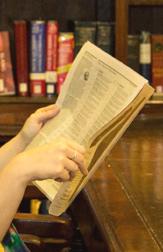The New York Society Library Opens Historic Ledger to Public in New Web Resource
February 7, 2011
NEW YORK, NY—In October 1789, The New York Society Library shared a building with the new federal government at Wall and Broad Streets in lower Manhattan. The Library's collection was used by members of Congress, the Cabinet, and the President himself. These and other patrons' transactions from 1789 to 1792 were meticulously recorded in the Library's first charging ledger. The Library is proud to make this historic treasure available to scholars and the public through a website showing the ledger pages, transcriptions, links for the patrons and titles, and information about the books and readers of the era. The site is http://www.nysoclib.org/collection/ledger/circulation-records-1789-1792/people.
The ledger features the borrowing history of George Washington, John Adams, John Jay, Aaron Burr, Alexander Hamilton, George Clinton, James Duane, and over 500 other New Yorkers. Over 1,100 titles circulated between 1789 and 1792, and several hundred are still in the Library's rare book collection. The ledger is a unique and informative historical document and a window into the reading habits of our nationís youth.
The New York Society Library, New York's oldest library, was founded in 1754 by a small group of civic-minded citizens wishing to increase the city's literacy and learning. In the eighteenth century, an organization labeled "Society" meant that it was open to all—available to everyone throughout society. By the time of the American Revolution, it held an estimated 1,300 volumes—a formidable collection in a time when books were printed and stitched together by hand. It resided in one room in the original City Hall.
In 1776, George Washington's Continental Army was driven from New York by the invading British. Washington looked the other way while teams of incendiaries set New York ablaze to deprive the British of winter quarters. In the ensuing chaos, the Society Library's collection was looted by infuriated British soldiers and sailors, who sold the books at nearby grog shops for a few gulps of rum. The Library more or less ceased to exist.
In 1788, New York became the capital of an independent nation with a new constitution and new government. A plaintive notice appeared in the newspapers, asking "such persons who have in their possession any of the books belonging to the New-York Society Library" to return them to any of several trustees. A surprising number of books surfaced, including six hundred hidden in St. Paul's chapel. In 1789, the library reopened in the same building on Wall Street, remodeled and christened Federal Hall. It now housed not only the city government but also the two branches of the new Congress and the offices of the president and vice president, causing their famous names to appear in the Library's ledger.
Examining the ledger, we learn that Aaron Burr was a voracious reader, making his way through Gibbon, Swift, and Voltaire; and that George Clinton was a serious reader, with not one novel on his list of Hobbes, Buffon, Tasso, Herodotus, and Polybius. About John Jay, William J. Dean remarked in his "Book Selections of the Founding Fathers" (New York Law Journal, February 8, 2007), "Chief Justice Jay must have had his own collection of law books, for few of the books borrowed by him from the New York Society Library are law-related. What stands out when examining the Library's charging ledger is both the breadth of his interests and his wide reading in literature, history, travel and science."
On October 5, 1789, President Washington took out The Law of Nations by Emer de Vattel. The book was not returned, nor any overdue fine paid. When the ledger's restoration and an inventory of the current collection showed that the book was still missing, Mount Vernon Estate & Gardens graciously replaced it with a copy of the same edition. This episode received extensive press coverage in April and May 2010.
The first ledger itself was misplaced for years and finally found in 1934, on a trash pile at 109 University Place, the Library's former location. It was intact but in extremely fragile condition. Due to support from an anonymous donor and Library member Christopher Gray, the ledger underwent extensive preservation and digitization by the Northeast Document Conservation Center and Library staff. The restored ledger and website were inagurated in December 2010.
In addition to the first ledger, the Library's archives hold more than seventy ledgers from the 19th and 20th centuries, possibly one of the most complete set of book circulation ledgers in the country. These ledgers are also of great interest and value to scholars. They show, for example, the books on whaling that Herman Melville took out and didn't return for two years while he was writing Moby-Dick. More broadly, they provide unique insights into the reading tastes of our early nation and many of its distinguished writers, who were among our members.
Today, The New York Society Library is open to all for reading, reference, and selected events, with circulation and other services by subscription. The beautiful landmarked building dates from 1917 and includes reading rooms, spaces for study, stacks open to members, an active children's library, and the Peluso Family Exhibition Gallery. The Library has approximately 275,000 volumes and hosts a variety of special events, reading groups, and workshops, as well as the New York City Book Awards. More information on the Library, its history and activities is available at www.nysoclib.org.

